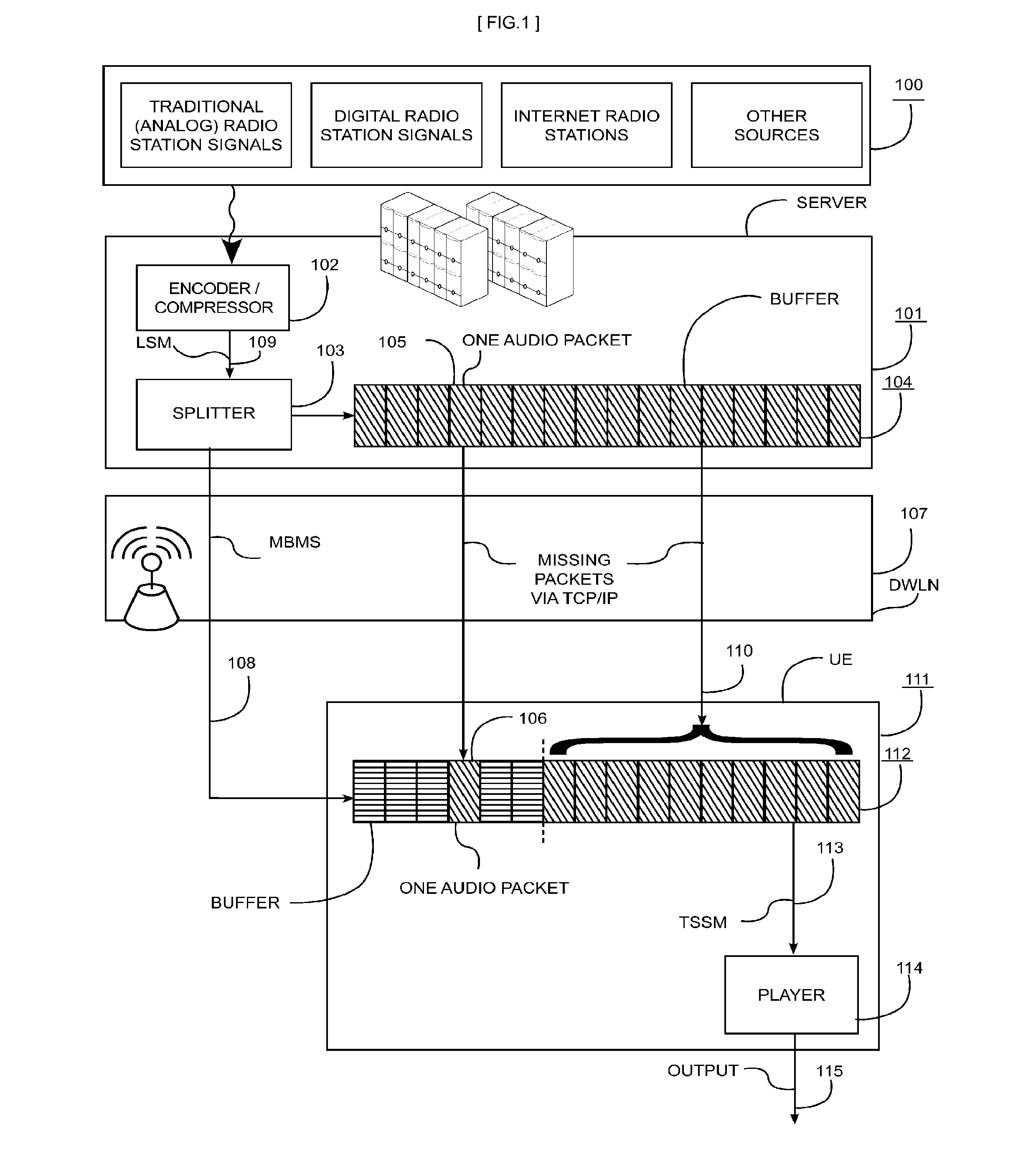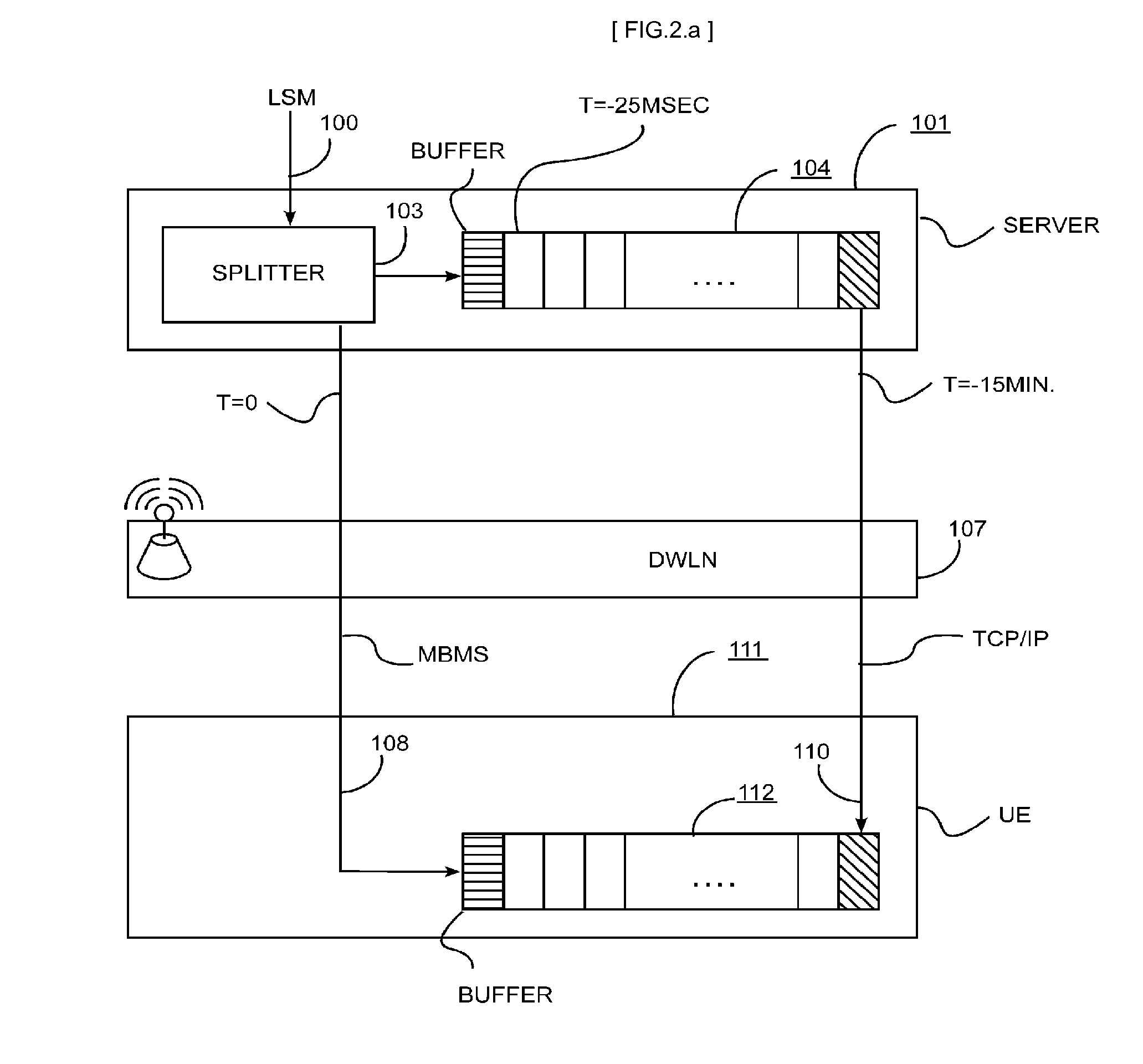These analog broadcast networks allow the use of only a limited number of channels, are subject to
cross channel interference and have a poor
signal quality.
Satellite or ground based digital broadcast networks such as
Digital Radio and Digital TV in various embodiments such as DAB, HD Radio, XM Radio, Sirius, Sat TV, DVB, DTT and DMB have removed or reduced these limitations using digital transmission in various forms and with various methods to deliver
live streaming media (LSM) such as audio / video, but these systems do not have a provision to assure the continuity of reception when the vehicles moves into areas of
signal obstruction or lack of coverage.
As such areas can be quite large, or the vehicle can be in such areas for a long time (e.g. because of slow moving traffic in long tunnels, urban canyons,
mountainous terrain), interruptions of the LSM can be quite long and annoying.
The DWLN can also be used to
stream media such audio / video to a vehicle with protocols such as radio or video on Internet, but the DWLN are subjected to similar limitations of
signal obstruction, or lack of coverage, as the other systems.
The long duration reductions of bandwidth are generally caused by problems in the
wireless segment of the network such as obstructions, interference,
cell changeover and distance from the transmitters.
Depending on the used protocol the reduction of bandwidth can cause only a
delay (e.g. as in TCP / IP protocol) or also a loss of data (e.g. in UDP / IP protocol).
Each of these factors can cause delays and interruptions in the transmission of data thus preventing the user from being able to listen to or view uninterrupted LSM unless some special provisions have been incorporated.
Dropouts can be extremely annoying, for example, while listening to music.
The long term interruptions are even more annoying and within this document we refer to them as outages.
This pre-buffering process avoids dropouts due to transmission delays shorter than the pre-buffering time, but it is not effective against loss of
streaming data.
Cumulative delays in the
receipt of audio / video data longer than 10 seconds cause the buffer to deplete.
Because transmission of audio /
video media data to the user takes place at the rate it is played out, the user's buffer level can never be increased or replenished while it is playing.
This method can be applied only to dropouts and streaming media of limited duration, otherwise the size of the pre-buffer has to be increased and the time required to fill it would require the user to wait for an uncomfortable time.
These analog broadcast networks allow the use of only a limited number of channels, are subject to
cross channel interference and have a poor
signal quality.
Satellite or ground based digital broadcast networks such as
Digital Radio and Digital TV in various embodiments such as DAB, HD Radio, XM Radio, Sirius, Sat TV, DVB, DTT and DMB have removed or reduced these limitations using digital transmission in various forms and with various methods to deliver
live streaming media (LSM) such as audio / video, but these systems do not have a provision to assure the continuity of reception when the vehicles moves into areas of signal obstruction or lack of coverage.
As such areas can be quite large, or the vehicle can be in such areas for a long time (e.g. because of slow moving traffic in long tunnels, urban canyons,
mountainous terrain), interruptions of the LSM can be quite long and annoying.
The DWLN can also be used to
stream media such audio / video to a vehicle with protocols such as radio or video on Internet, but the DWLN are subjected to similar limitations of signal obstruction, or lack of coverage, as the other systems.
The
short duration reductions of bandwidth are caused by many factors such as congestion of the wireless or land segment of the network, interference and
transmission quality issues.
The long duration reductions of bandwidth are generally caused by problems in the wireless segment of the network such as obstructions, interference,
cell changeover and distance from the transmitters.
Depending on the used protocol the reduction of bandwidth can cause only a
delay (e.g. as in TCP / IP protocol) or also a loss of data (e.g. in UDP / IP protocol).
Each of these factors can cause delays and interruptions in the transmission of data thus preventing the user from being able to listen to or view uninterrupted LSM unless some special provisions have been incorporated.
Dropouts can be extremely annoying, for example, while listening to music.
The long term interruptions are even more annoying and within this document we refer to them as Outages.
This pre-buffering process avoids Dropouts due to transmission delays shorter than the pre-buffering time, but it is not effective against loss of
streaming data.
Cumulative delays in the
receipt of audio / video data longer than 10 seconds cause the buffer to deplete.
Because transmission of audio /
video media data to the user takes place at the rate it is played out, the user's buffer level can never be increased or replenished while it is playing.
This method can be applied only to Dropouts and streaming media of limited duration, otherwise the size of the pre-buffer has to be increased and the time required to fill it would require the user to wait for an uncomfortable time.
 Login to View More
Login to View More  Login to View More
Login to View More 


